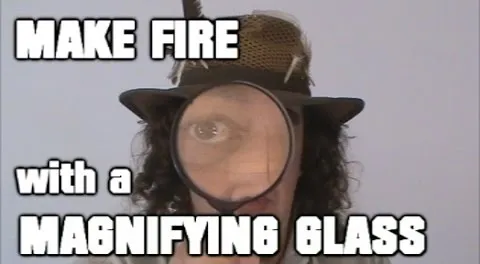The worst can always happen. Even if you think you're absolutely prepared, you can somehow find yourself stranded in the middle of nowhere by yourself. It can happen. Without a map, without a compass, without a cell phone... without food and water.
There are plenty of dangerous hikes in the world. Lingshan Mountain in Beijing, Machu Picchu in Peru, Mount Pinatubo on the island of Luzon, and the aptly named "Maze" in Utah's Canyonlands. These are all dangerous backpacking treks that require a certain degree of experience, otherwise you're chances of getting lost or stranded are tenfold.

Lingshan Mountain — extremely beautiful and equally threatening

Machu Picchu — very ethereal, yet devilishly dangerous

Mount Pinatubo — vivacious, but actively volcanic

The Maze — this puzzle could cost you your life

Lingshan Mountain — extremely beautiful and equally threatening

Machu Picchu — very ethereal, yet devilishly dangerous

Mount Pinatubo — vivacious, but actively volcanic

The Maze — this puzzle could cost you your life
But hiking isn't the only occasion where you can find yourself alone, hungry, and cold. There are many possibilities, some for which you would never predict being alone without food or water. You could simply run out of gas in a desolate land. You could be the sole survivor on a tucked away island (think LOST). A nuclear fallout might leave you hunting and scrounging for food. Or with today's continuing war, you could find yourself alone in the middle of Iraq — a hostile environment in every way, shape, or form.

Let's use Iraq as an example then. With today's war, being by your lonesome in the deserts of Iraq isn't the only time you might have to fend for your own food and water. Even near large cities like Baghdad or Fallujah, you might want to do your best to keep hidden and survive off the land, until an opportune time for rescue. Eating unknown plants or trapping and killing small animals for food may be your best option for survival.
 There are large animals you could kill for food, like sheep and goats, but they always belong to somebody, and bigger is never better in such occasion. Keeping things small means remaining tactical and impregnable, and the most common small mammals you will find in Iraq are rodents. There are Euphrates Jerboas, which are commonly found near the mountains around abundant vegetation, but they can also be found in the desert areas around seed food resources.
There are large animals you could kill for food, like sheep and goats, but they always belong to somebody, and bigger is never better in such occasion. Keeping things small means remaining tactical and impregnable, and the most common small mammals you will find in Iraq are rodents. There are Euphrates Jerboas, which are commonly found near the mountains around abundant vegetation, but they can also be found in the desert areas around seed food resources.
An odd rodent to capture would be the Middle East Blind Mole Rat, otherwise known as the Palestine Mole Rat. They spend the majority of their
lives underground, feeding off roots and bulbs, but they are known to peek their heads out to hunt for above ground food.

Mole Rat

Mole Rat

Mole Rat

Mole Rat holes

Mole Rat

Mole Rat

Mole Rat

Mole Rat holes
 Another well-known rodent in Iraq is the Persian Jird, with long ears and dark black eyes. They're seen more in a rocky dry environment and semi-desert environments, and can also live nearby humans, under walls, and by rocks.
Another well-known rodent in Iraq is the Persian Jird, with long ears and dark black eyes. They're seen more in a rocky dry environment and semi-desert environments, and can also live nearby humans, under walls, and by rocks.
Other rodents native to Iraq are field mice, gerbils, rats, and squirrels. These are the mammals you're going to end up catching, or killing in Iraq. Deadfall traps are the best way to hunt for small game, especially in Iraq around a hostile society. You can't hunt with your rifle (if you have one) unless you want to draw attention to yourself, so you need to be able to be intuitive. Deadfall traps are the answer.
Deadfall Trap Preparations
Before you go right into making a deadfall trap to kill your lunch, you need to know a few things. A few properly placed deadfall traps will catch more game than a man with a rifle will ever shoot. If you're hunting small rodents, there's no point in hunting with a rifle anyway, unless you want to waste most or all of the meat.
Familiarize
You need to familiarize yourself with your prey in order to catch them. Know what you intend to catch and know their living patterns. The more you know about your prey, the more likely you are to catch them.
Stay Undetected
When familiarizing yourself with your chosen prey, make sure you do not alarm the prey. Try to stay unnoticed and try not to leave signs of your presence, like trash and urine. The less they know you're watching, the more likely they are to go about their everyday routine.
Look for Signs
Most times you won't actually be able to see the patterns of your prey. In that case, search for identifying signs of their presence. Look for runs and trails, tracks, droppings, chewed or rubbed vegetation, nesting or roosting sites, and feeding and watering areas.
Trap Location
In order to effectively catch a small animal, your trap needs to be placed in an adequate area. Position your traps where there is proof that animals pass through. Placing a trap in a trail is more likely to catch an animal, because a trail is used by several species, which gives a better chance of actually catching something. A trail is more visually distinct from a run, which only contains signs of one species, making the trail easier to detect.
A perfectly built deadfall trap doesn't mean anything unless placed in the proper location. Small animals have burrowing holes, bedding areas, waterholes, and feeding areas with trails interlaced between them. These are the places that must contain the traps.
Trap Concealment
When in hostile territory like Iraq, trap concealment is important. If noticed by angry locals or insurgents, you'll be the one being hunted, not the rodent. Cover the trap with nearby vegetation to blend into the environment. If in the desert, throwing some sand on and around the trap may be sufficient enough for camouflage.
Prepare Away from Trap Location
To avoid disturbing too much of the local vegetation around your trap placement, consider building your trap in a different location, then bringing it into your desired setting. Prepare your traps away from the site, carry them in, and set them up. This really helps out creating a comfortable environment for your prey. Do not, however, use any freshly cut vegetation for your trap building or concealment. Fresh cut wood and plants will ooze sap, which contains an odor that certain prey can smell. It alerts them to danger and they will avoid your trap.
Mask Your Scent
When you build and set a trap, you automatically leave your scent behind. To prevent scaring the small animals, you will need to remove or mask your scent. Almost all mammals depend on their sense of smell to alert them of danger.
Actually removing your scent is a near impossible task, so you will have to rely mostly on masking it. If you've already killed something, use the fluid from their gall bladders and urine bladders to apply on the trap. However, do not use human urine.
Use mud from an area with dead and rotting vegetation to mask your scent. Not only can you use it directly on the trap, you can coat your hands with mud while building the trap to prevent leaving your scent behind.
You can also smoke parts of the trap to hide your scent. Most animals are well aware of the smell of burnt vegetation and smoke, but are only alarmed when a fire is actually burning, leaving smoking a good method for masking your odor.
In Iraq, in hostile territory, building a fire for smoking may not be very tactical. Also, you may not be around muddy land or have killed a mammal already. In that case, try weathering. Build the trap and allow it to weather for a few days before setting it up in its desired location. During weathering, do not handle the trap.
Quantity
Let's face it, you're probably not going to have much luck setting up just one trap. To be effective at catching your desired prey, you will need to set up two or three or even four traps. The more traps you make, the more successful you will be at avoiding starvation.
Making the Figure-Four Deadfall Trap
There are actually two versions of a deadfall trap, one being the figure-four trigger and the other being the Paiute trip-string trigger deadfall trap. The figure-four relies on making the trigger out of sticks, while the other uses sticks and cordage. This article focuses on the easiest version, the figure-four, because when under pressure and in hostile and unknown land, the easiest option is the best option.
Whether you have or can make string or cordage will discern which trap you will want to make, but again, this article only focuses on the figure-four. Both traps work on the principle of a weight falling on the prey once bait is taken, and they can be made to fit any size animal.
The figure-four consists of a horizontal bait bar perpendicular to an upright stick with a diagonal locking bar angled above it that supports the weight of the heavy stone, rock, or log.

You can also use anything that is heavy enough to kill or seriously injure your desired prey, like a brick, but using natural items unique to the surrounding environment will work best.
The Weight
The first thing you need to do is discern what size weight you will need for your prey. Find the appropriate size rock, boulder, or log that is heavy enough to kill or hinder.

The Wood
After you have picked your weight, you will need to find three pieces of thin wood for your trigger mechanism. Thick and sturdy tree limbs work best. Twigs will not provide adequate support for the weight. The length of the sticks depends on how high you want to position your weight above the ground. The thickest piece of wood should be used as the diagonal bar, since it supports most of the weight.
 A. Prepare the Upright Stick
A. Prepare the Upright Stick
Cut a small two-sided flat edge onto the tip of the upright stick.
Then cut a square notch near the middle in the right orientation to the cut at the tip. The squared notch should be only big enough to fit the bait stick.


B. Prepare the Release Stick
Cut a small angled notch near the top of the diagonal release stick, careful not to make this cut to close to the edge. This notch should fit the two-sided flat edge on the tip of the upright stick.

Now make a two- or one-sided flat edge cut on the opposite end of the release stick (whichever works best for you), similar to the one on the upright stick. Make sure it is in the proper orientation.

 C. Prepare the Bait Stick
C. Prepare the Bait Stick
For the horizontal bait stick, first cut an angled notch near the end of the stick. This notch should fit the two-sided flat edge on the tip of the diagonal release stick.
The last cut you will need to make is a small notch at a point in the middle of the bait stick where it meets the upright stick when set up. This notch will connect with the other notch to form the stability of the trap, which is essentially the trigger. You can angle the cuts to make the trap more sensitive to touch. The more sensitive it is, the more successful it will be.

You can even add one more cut if you'd like, at the end of the bait stick, where the bait will actually be placed. Cut this point however you like.

Bait point cut

Completed bait stick (view 1)

Completed bait stick (view 2)

Bait point cut

Completed bait stick (view 1)

Completed bait stick (view 2)
Your complete figure-four should look like this now.

The Bait
For the bait, you need to find something edible and appealing, specific to the animal being hunted. The Euphrates Jerboas is an omnivore, so use earthworms or various insects as bait. You can also use berries, nuts, seeds, grapes and bulbs as bait, among other things.
When hunting the Palestine Mole Rat, use roots, tubers, and bulbs of trees and plants as bait. For Persian Jirds, use small plant materials, grains, and insects. Basically, use your best judgment when picking bait. If you had been familiarizing yourself with the animal, you will know what to use and what not to use as bait.
When placing the bait, simply stab it into the end of the horizontal bait stick of the trap. It's best to place bait before actually setting up the trap, to avoid accidentally tripping it yourself.
Setup
The setup is easy for this deadfall trap. Gather your weight and three pre-cut sticks, along with your bait. Attach your bait to the bait stick, and then proceed to set up the actual trap.
Set the upright stick into the ground, and then insert the horizontal bait stick into the upright stick. While holding both sticks in place, mount the diagonal release stick. Once set, gently support the upright stick while you place your weight atop the release stick. When set, gently let go of the upright stick and weight. It may take a few tries to make the trap sturdy enough, so don't fret.






After completely set, go through camouflaging and masking your scent, if not already done. To be good at making this trap, it will probably take a few tries. Not everyone will succeed in making one on their first try, so don't give up. More than likely you won't be able to give up, unless you want to starve and become weak, which is not going to help you when stranded in a hot and hostile environment like Iraq or Utah's Canyonlands.
This is basic survival knowledge. Knowing this simple dead fall trap is the key to surviving alone in the woods, mountains, or desert, because you never know what might happen. You could find yourself in a situation where you need food, and this is how you're going to get it.






















Comments
Be the first, drop a comment!